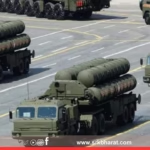In a development that has sent shockwaves through global defence circles, Ukraine has reportedly destroyed Russia’s advanced S-400 Triumf air defence system using drone and missile strikes. This event, unfolding in the backdrop of Russia’s ongoing war in Ukraine, has sparked serious debates within strategic communities in India, which is a major S-400 importer, about the future reliability of the system.
The Attack: How Ukraine Neutralised The S-400
Reports suggest that Ukraine targeted Russia’s S-400 system stationed in occupied Crimea using a combination of naval drones and modified long-range missiles. This is not the first time Ukraine has claimed to destroy an S-400 battery, but recent satellite imagery and multiple intelligence sources indicate a confirmed hit, resulting in:
- Complete destruction of the radar and launch vehicle
- Elimination of personnel operating the system
- Loss of advanced interceptor missiles stored on site
Military analysts note that Ukraine’s high-speed drone swarms, decoy tactics, and covert special operations were key to breaching the S-400’s detection perimeter.
Why Is The S-400 Considered Invincible?
The S-400 Triumf, developed by Russia’s Almaz-Antey, is regarded as one of the world’s most sophisticated surface-to-air missile systems. Key features include:
- Engagement range up to 400 km, targeting aircraft, cruise missiles, and ballistic missiles
- Ability to track up to 80 targets simultaneously
- Multi-layered radar and missile batteries for interception at various altitudes
India purchased five S-400 regiments worth over $5.4 billion in a 2018 deal, with deliveries continuing despite US CAATSA sanctions threats.
Indian Strategic Concerns After The Strike
| Concern | Details |
|---|---|
| Survivability against modern drone warfare | Ukrainian tactics demonstrated how low-cost drones and decoys can overwhelm static air defence systems. |
| Mobility challenges | The size and logistical footprint of S-400 batteries make rapid redeployment difficult under persistent drone threats. |
| Electronic warfare vulnerability | Ukraine has reportedly used electronic countermeasures to suppress S-400 radars. |
| Battlefield transparency | High-resolution satellite imagery and Western intelligence allowed precise targeting of concealed Russian assets. |
Expert Opinions From India’s Defence Community
- Air Marshal (Retd) Anil Chopra, former Director General, Centre for Air Power Studies, notes:
“The S-400 remains potent, but static SAM systems need layered defence and anti-drone countermeasures. India must integrate indigenous drone jammers and kinetic kill systems to protect such assets.” - Lt Gen (Retd) DS Hooda, ex-Northern Army Commander, argues:
“This attack shows no single system is invincible. India should invest in resilient, redundant air defence networks combining S-400 with Akash NG, DRDO’s anti-drone weapons, and mobile point-defence units.” - Dr. Brahma Chellaney, strategic affairs analyst, warns:
“Russian battlefield setbacks should be a wake-up call. Overdependence on any one supplier compromises operational autonomy.”
Implications For India’s Defence Planning
India’s integration of S-400 regiments is crucial for defending high-value targets such as:
- New Delhi and Mumbai metropolitan regions
- Nuclear command and control sites
- Forward Air Force bases in Punjab, Rajasthan, and Ladakh
- Critical naval infrastructure on the western and eastern seaboards
However, evolving drone warfare demands multi-tiered counter-unmanned aerial systems (CUAS) to complement the S-400’s ballistic and cruise missile defence roles.
Ukraine War: Lessons On Drone Warfare
The Ukraine conflict has showcased how small, low-RCS (Radar Cross Section) drones carrying explosive payloads can evade or saturate legacy radar systems. Key takeaways include:
- Cost asymmetry: $10,000 drones neutralising multi-billion dollar systems
- Decoy effectiveness: Dozens of decoy drones can confuse radars, enabling real strikes
- AI-guided swarm attacks: Increasingly adopted by militaries for SEAD (Suppression of Enemy Air Defences) missions
How Is India Responding?
India’s Defence Research and Development Organisation (DRDO) has accelerated indigenous CUAS development, including:
- D4 anti-drone system: Deployed at major airports and defence sites
- Laser-based Directed Energy Weapons (DEW): Trials underway for neutralising drones within a 5-7 km radius
- Skystriker and ALFA-S drones: Indigenous kamikaze drones that can perform similar SEAD roles in offensive operations
Furthermore, the Indian Air Force is exploring joint projects with Israel to upgrade S-400 regiments with advanced electronic warfare suites.
Russia’s Defence Ministry Reaction
Following the recent destruction of S-400 units, Russia downplayed the damage, insisting their system remains “impenetrable against enemy aircraft and missiles.” However, independent analysts point to credible losses in Crimea, Luhansk, and Belgorod regions.
Global Perceptions Of Russian Weapons
The repeated neutralisation of flagship Russian weapons systems in Ukraine is impacting global arms sales:
| Country | Recent Developments |
|---|---|
| Turkey | Questioning further S-400 purchases after integration issues with NATO defences |
| China | Continuing deployments but investing heavily in indigenous HQ-9B upgrades |
| Saudi Arabia & UAE | Shifting preference towards US THAAD and Patriot PAC-3 upgrades |
Future Outlook: Should India Rethink S-400 Dependence?
While India remains committed to its current S-400 contracts, defence planners are reportedly evaluating:
- Accelerating MR-SAM and XR-SAM indigenous programmes
- Expanding Akash NG regiments for layered air defence
- Integrating AI-based drone detection and kinetic interceptors
Senior officials argue that abandoning S-400 mid-way is impractical due to sunk costs and current geopolitical constraints, but diversifying suppliers and boosting indigenous systems is essential for long-term strategic autonomy.
Conclusion
Ukraine’s successful drone strike on Russia’s S-400 system is a stark reminder that no platform is invulnerable in modern warfare. For India, it signals an urgent need to complement its flagship missile defence purchases with robust counter-drone, electronic warfare, and indigenous layered defence solutions to future-proof national security in an era of evolving drone and AI-guided threats.











